Climate
-
Temperature
15-32°C -
Rainfall
600-1000mm -
Sowing Temperature
15-20°C -
Harvesting Temperature
30-32°C
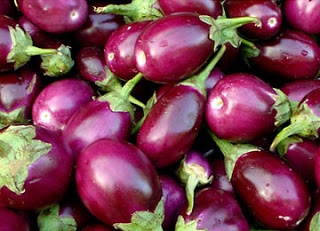
















Brinjal is a hardy crop so it can be grown on different type of soils. As it is a long duration crop, it required well drained fertile sandy loam soil is best suited for its cultivation and gives good yield. For early crop light soil is good and for high yield clay loam, silt loam are suitable. For good growth pH of soil should be 5.5 to 6.6.
Arka Nidhi: New variety, light blue to black color fruits which are 20-24cm long. It gives an average yield of 125qtl/acre.
H-8 (HIsar Shyamal): Round fruit, attractive purple color and are soft. It gives an average yield of 105qtl/acre.
Arka Keshav: New variety, resistant to bacterial wilt disease, long fruits in bunches, red purple attractive skin, first harvesting is done in 65-70 days and it gives an average yield of 66-84qtl/acre.
Pusa Purple Cluster: Fruits are 10-12cm long, deep purple color and in bunches (4-9 fruits in single bunch). It gives an average yield of 42-52qtl/acre.
Pusa Kranti: Fruits are 15-20cm long, attractive color and soft. It gives an average yield of 84qtl/acre.
Pusa Purple Long: Fruits are 20-25cm long, light purple color, thin peel and soft. It gives an average yield of 105qtl/acre.
Pusa Anupam: It has 70-80cm plant height. Fruits are 15-20cm long, purple color, in bunches (3-5 fruits per bunch). The variety gets ready in 100-110 days and gives an average yield of 200qtl/acre.
T-3: It has round fruits, 10-12cm long and light purple in color. It has 50-60cm plant height. The variety gets ready in 80-90 days and gives an average yield of 185qtl/acre.
Other state varieties
Long Varieties
Pusa Purple Long: Early maturing variety. Ready to harvest in 70-80 days after sowing in winter season and 100-110 days during summer season. Plant having medium height, fruits are of long, purple color. It gives average yield of 125-130 qtl/acre.
Pusa Purple Cluster: Developed by ICAR, New Delhi. Medium duration variety. Fruits are of deep purple color and borne in clusters. It is moderately resistant to bacterial wilt.
Pusa Kranti: Developed by IARI, New Delhi. Suitable for spring and autumn season. Ready to harvest in 130-150 days. Fruits are of attractive dark purple color. It gives average yield of 56-64 qtl/acre.
Round Varieties
Pusa Hybrid 5: Fruits are long with dark purple color. Ready to harvest in 80-85 days. Gives average yield of 204qtl/acre.
Pusa Purple Round: It is tolerant to little leaf and shoots and fruit borer.
Pant Rituraj: Fruits are round with attractive purple color with less seed. Gives average yield of 160qtl/acre.
Hybrid Varieties
Pusa Anmol: Hybrid developed by IARI, New Delhi. Gives 80% more yield than pusa purple long.
Pusa Hybrid 6: Hybrid developed by IARI, New Delhi. Fruits are round, glossy with attractive purple color. Ready to harvest in 85-90 days. Gives average yield of 180qtl/acre.
Arka Navneet: High yielding variety developed by IIHR, Banglore. Ready to harvest in 150-160 days. Fruits are large in size with oval to oblong shape. They have excellent cooking quality. Gives average yield of 260-280qtl/acre.
Neelima: First wilt resistant variety in India, released by KAU. Fruits are large and oval. Gives average yield of 260qtl/acre.
Swetha: Bacterial wilt resistant variety released by KAU. Fruits are medium long and of white color. Gives average yield of 120qtl/acre.
Plough land for three- four times and bring soil to fine tilth. Apply well decomposed cowdung@42qtl per acre and mix well in soil.
Time of sowing
Low areas: October-November and February-March.
Intermediate areas: May-June and March-May.
Spacing
Use row to row spacing of 60-70cm and plant to plant spacing of 60cm.
Sowing Depth
In nursery sow seeds at depth of 1.5cm and then covered with soil.
Method of sowing
Transplantation of seedling in main field.
Seed Rate
For one acre of land sowing, use seed rate of 250-300gm.
Seed Treatment
For sowing use only trusted and good seeds. Before sowing do seed treatment with Thiram@3gm or Carbendazim@3gm/kg of seeds. After chemical treatment, treat seeds with Trichoderma viride@4gm/kg of seed, dry in shed and sow immediately.
| Fungicide/Insecticide Name | Quantity (per kg) |
| Carbendazim | 3gm |
| Thiram | 3gm |
| Trichoderma viride | 4gm |
Fertilizer Requirement (kg/acre)
| UREA | SSP |
MOP |
| 92 | 156 | 35 |
Nutrient Requirement (kg/acre)
| NITROGEN | PHOSPHORUS | POTASH |
| 42 | 25 | 15 |
Apply fertilizer dose of Nitrogen@42kg in the form of Urea@92kg/acre, Phosphorus@25kg in the form of SSP@156kg/acre and Potash@15kg/acre in the form of MOP@35kg/acre in soil and mix well. Half dose of urea and full dose of SSP and MOP is added at the time of transplanting. Rest of the urea is added in two equal splits at the interval of 1month.
WSF: Apply Humic acid@1Ltr/acre or do soil application of 5 kg granules/acre, in initial vegetative growth of crop. It will help in better vegetative growth and good yield. 10-15days after transplantation take spray of NPK 19:19:19 @10gm along with micronutrient@2.5 to 3gm/Ltr of water. In vegetative growth, sometime due to low temperature plant cannot absorb nutrients from soil, plant get weak and give yellow appearance. In such situation give spray of NPK 19:19:19 or 12:61:00@5-7gm/Ltr of water. If required, repeat spray after 10-15 days. 40-45 days after transplantation, take spray of 20% Boron@1gm along with micronutrient@2.5 to 3 gram per liter of water. To fulfill nutrient requirement and to increase yield by 10-15%, give two sprays of NPK 13:00:45@20gm/Ltr of water. Give first spray at 50days and second 10days after first spray. When the crop is in flowering or fruiting stage, take spray of 00:52:34 or NPK 13:00:45@20gm/Ltr of water.
In high temperature flower drop is observed, to control flower drop take spray of NAA@4ml/15Ltr water when crop is in flowering stage. Repeat spray after 20-25 days.
Generally two - four weeding’s and hoeing are necessary for weed control, aeration and for the good growth of plants. Mulching with black polythene film reduces weed growth and maintains soil temperature.
To control weeds efficiently, do pre-plant soil application of Fluchloralin@600-800 ml/acre or Oxadiazon@400gm/acre and pre-plant surface spraying of Alachlor@2 ltr/acre for better results.
Irrigate the field after every third or fourth day during the summer season and after 12 to 15 days during the winter season. Timely irrigation is very important for high yields of brinjal. Brinjal fields should be regularly irrigated to keep the soil moist during frosty days. Avoid water stagnation in field as brinjal cannot tolerate water logging.
Fruit and Shoot Borer: It is one of the major and serious insect pests of brinjal. A short pinkish caterpillar bores into the terminal shoot and eats internal tissue in initial stages, later it bores into the young fruit. The large holes can be seen on the infected fruits. The insect affected fruits become unfit for consumption.
Scout field every week after transplanting for fruit and shoot borer infestation. Remove and destroyed infected fruits. Take spray of Triazophos@20ml/10Ltr water and Neem extract@50gm/Ltr, one month after transplanting. Repeat spray with interval of 10-15 days. When crop is in flowering stage take spray of Chlorantraniliprole 18.5%SC (Coragen)@5ml+Teepol@5ml in 12 Ltr of water, twice with 20 days interval.
In initial stage of infestation, take spray of 5% Neem extract@50gm/Ltr. If infestation is seen in field take sprayed of 25% Cypermethrin@2.4 ml/10Ltr of water on affected crops. For high population spray Spinosad@1ml/Ltr of water. Avoid spraying of Triazophos or any other insecticide after fruit maturation and harvest.
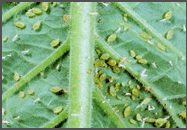
Aphids: The plants are also attacked by mite, aphids and mealy bug. They suck the sap from the leaves resulting in yellowing and drooping of leaves.
If infestation of Aphid, white fly is observed in field to control take spray of Deltamethrin + Triazophos combination@ 10ml/10Ltr of water. To keep check on white fly spray with Acetamiprid@5gm/15Ltr of water.
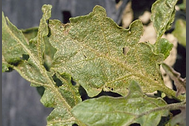
Thrips: To check severity of thrips, keep blue sticky traps@6-8 per acre and to reduce the incidence take spray of Verticillium lecani@5gm/Ltr of water. If incidence of thrips is more, to control take spray of Fipronil@2ml/Ltr of water.
Mite: If infestation of Mite is observed in field, to control take spray of Abamectin@1-2ml/Ltr or Fenazaquin@2ml/Ltr of water.
Leaf eating caterpillar: Some time Incidence of caterpillars is seen mostly at initial stage of crop.
To control spray with neem based pesticides. If those are not that effective and infestation become high then only take spray of chemicals pesticides like Emamectin benzoate@4gm or Lambda Cyhalothrin@2ml/1Ltr of water.
Root Knot Nematodes: It is common in brinjal crop. These are more harmful at initial stage of seedlings. They cause root galls. Due to infestation of root knot nematodes, plant get stunted, give yellow appearance and thus affect yield.
Avoid monocropping and follow crop rotation. Incorporate Carbofuran or Phorate@5-8kg/acre in the soil.
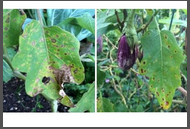
Damping Off: Moist and poorly drain soil causes damping off disease. It is soil borne disease. Water soaking and shriveling of stem occurs. Seedlings killed before emergence. If it appears in nursery the entire lot of seedling may get destroyed. It is a serious disease of brinjal.
Before sowing do seed treatment with Thiram@3gm per Kg of seeds. Do soil solarization of nursery soil. If damping off is observed in nursery. Drained out water and drenched soil of nursery with Copper Oxychloride@3gm/Ltr of water.
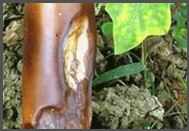
Phomopsis Blight and Fruit Rot: Dark brown color spots appear on leaves. The fruit show watery lesion and becomes black in appearance.
Before sowing do seed treatment with Thiram@3gm per kg of seeds. Use blight disease resistant variety for cultivation. If infestation observed in field take spray of Zineb@2gm/Ltr of water or Mancozeb@2.5gm per liter of water.
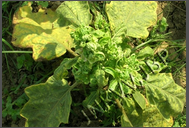
Little Leaf: The affected leaves become thinner. The petal turn green leaf like. Infected plant does not bear fruit. The disease is transmitted by leaf hopper.
Use disease resistant variety. In nursery use 10% Foret (20gm, for 3 X 1m broad bed). At time of sowing apply Phorate in between two rows of seeds. If infection observed, at initial stage, removed disease affected plants. Spray the crop with Dimethoate or Oxydemiton Methyl@1ml per litre of water. Little leaf is spread mainly through Aphid infestation, To keep check on Aphid Population spray with Thiamethoxam 25%WG@5gm/15Ltr of water.
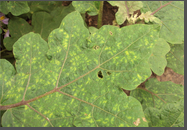
Mosaic: Light and green patches observed on leaves. Small bubbles or Blisters are form on leaves and leaf size remains small.
Select healthy and disease free seeds for cultivation. Uproot and destroyed infected plant away from field. Recommendations given for aphids may be adopted. (Take spray of Acephate 75SP@1gm/Ltr or Methyl demeton 25EC@2ml/Ltr of water or Dimethoate@25ml/Ltr of water.
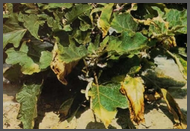
Wilt: Dropping of entire leaves along with yellowing of crops. Wilting or drying of entire plant is seen. If infected stems cut and dipped in water, a white milky stream appears.
Follow crop rotation. Cultivation of brinjal after french bean helps in controlling wilt. Remove and destroyed infected plant parts away from field. Avoid water stagnation in the field, to control wilt drench soil with of Copper Oxychloride@2.5gm/1Ltr of water.
Brinjal is harvested when the fruit attain proper size, color and before ripening stage. The fruit should have glossy appearance, attractive bright color to fetch good prices in the market.
Brinjal fruits cannot be stored at room temperature for long duration because of high transpiration rate and water loss. Brinjal fruit can be stored for 2-3 weeks at 10-11°C temperature and 92% relative humidity. After harvesting, grading is done on the basis of quality like super, fancy and commercial. For packing, use gunny bags or baskets.
Brinjal belongs to Solanaceae family, considered native to India and is a widely grown vegetable in Asian countries. It is a hardy crop than other vegetables. Due to its hardness, it can be successfully grown in dry area with low irrigation facilities. It is moderate source of Vitamins and minerals. It can grow throughout the year. India is second largest producer of brinjal after China. In India major Brinjal growing states are West Bengal, Orissa, Karnataka, Bihar, Maharashtra, U.P, and Andhra Pradesh.
In Himachal Pradesh, Brinjal is suitable for sowing in low and intermediate areas. In lower areas its farming is done in spring-summer or rainy-autumn season and in intermediate areas, farming is done in April to October month. 105 acres of land is used for brinjal farming and an average yield of brinjal production is 1650 tonnes in one year.
You have successfully login.
Your email and password is incorrect!